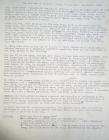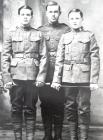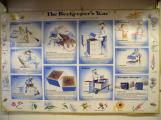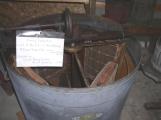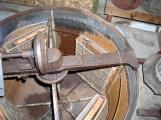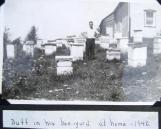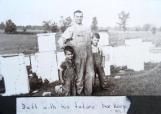2
The Crerar family emigrated to Canada in 1852 from Perth, Scotland. In 1914, during the First World War, Duff Crerar, of Osgoode Township, had procured his first hives of honey bees. These were of the Italian strain.5
He later left these hives in the care of his father, Peter, white he went to war overseas.Upon his return, he again cared for his hives, along with mixed farming on the family's land.
7
The Beekeeper's Year is a Busy OneBeekeeping is by no means a seasonal occupation. Various tasks have to be done throughout the year. Read the following and imagine you have several hundred hives under your care and only about 30 days in every month!
(The following comes from an early 1900's chart on display in the Crerar Honey Shop.)
January - February: Study and Workshop Time
Catch up on your "bee reading".
Nail up frames.
Get supers filled and ready
March: Looking Time
On any warm flyable day, examine all colonies.
Double check any not flying.
Remove any dead colonies.
Start feeding any very light colonies.
Winter packing may be removed, but leave on entrance reducer.
April: Getting Ready Time
Definitely the time to check for for winter starvation.
Winter packing should be removed.
Feed light colonies, preferably with sugar syrup over inner cover hole, with winter screen removed.
Surround jar/pail with an empty hive body so bees can feed in bad weather when they cannot move down to an entrance feeder.
May: The Critical Time !
This is the key month!
On a warm day, frames should be removed to check colony's condition: lack of stores or poor queen (uneven brood pattern); colony not building up and egg laying workers (all bullet-shaped drone cells).
When dandelions and fruit trees bloom, colonies should be stripped down on a warm day.
The bottom board should be cleaned of dead bees and debris because they retain moisture and restrict space.
Colonies showing fast buildup and extra strength should have their bodies reversed.
Keep entrance reducer on because the nights are still chilly. Remove only after warm weather is firmly established.
On extra strong colonies, tip back upper hive body and look underneath for swarm cells and if found, do something about it ! For the sake of your neighbours, for the hope of making a honey crop, don't let your colonies swarm !
June: Swarming Time
Early June is definitely the time to look for signs of swarming. A swarmed out hive will not produce a honey crop, may even loose its queen and finally the whole colony.
To prevent swarming, reverse the hive bodies.
Overcrowded colonies will cover the top frames when the inner cover is removed.
Add a super on to the top or in between to avoid overcrowding.
Or, raised sealed brood to an additional hive body. Especially frames having queen cells hanging down from bottom bars that show glistening royal jelly at the bottom of the queen cells.
Place these frames (filling in with additional frames) over a double screened inner cover with a notch or slot rim (to either side) for an entrance.
One can always pull out the board and reunite if no new queen shows up.
July: Supering Time
Watch the honey flow.
Any new white wax along the edges of the top bars means the colony needs a super.
SUPER AHEAD OF THE FLOW !
An extra super or two is good insurance. It gives bees more moving around space and keeps them happy.
Watch for any colony slowing down - not flying like it should. Don't ignore it.
Check inside. Disease? No queen? Too many drone cells?
Frames with too many drone cells should be moved to outer sides and eventually replaced and melted down.
August: Honey Crop Time
Super if necessary.
Remove filled supers.
Extract them and return them to the colonies if you are short of supers.
Some books say August is requeening time, but that is an optional procedure.
September: Extracting Time
Honey should be extracted while the weather is still fairly warm unless one can afford a "hot room".
Late September, after the first frost, get those mouse guards on.
Build up winter stores, supers should be off to force the bees to fill the empty brood areas from the fall flow.
October: Feeding Time
Lift each colony from the rear.
If it seems glued down it should have sufficient stores for the winter.
Feed light colonies generously and steadily between October 1st and 25th.
Give each colony a sprinkling of powdered sugar over the top bars.
It's the honey over cluster that counts.
Bees can starve with oodles of honey on the sides if they cannot break the cluster to move.
The centre frames in the upper body should be solid with honey!
An extra super of honey is always good insurance.
Some springs are delayed, cold and wet.
November - December: Wrap Up Time
Get colonies insulated.
Chips, sawdust and/or leaves in a burlap bag over the top cover surrounded by an empty super box keeps moisture from condensing and dripping from cold inner covers.
A piece of screen thumb tacked over the centre hole will keep bees from chewing the bag.
An upper ventilation hole is very necessary.
MOISTURE ACCUMULATION, NOT COLD, kills a colony.
Possibly a final tar paper wrap around the hive body and folded under the cover provides a wind break and keeps the insulation dry.
December is then a time to relax and reflect on the year's activity.
The End of A Busy Year

